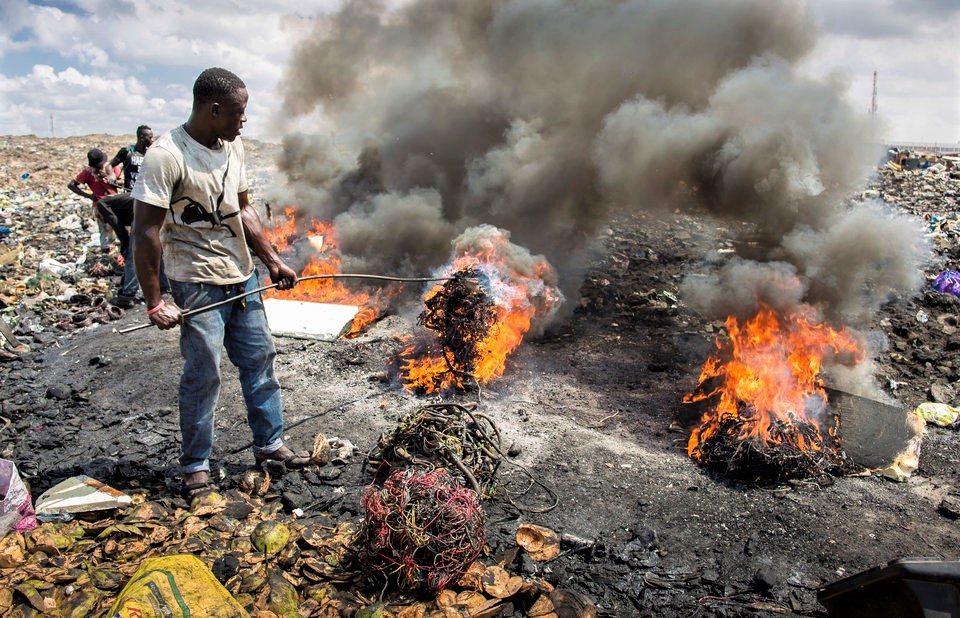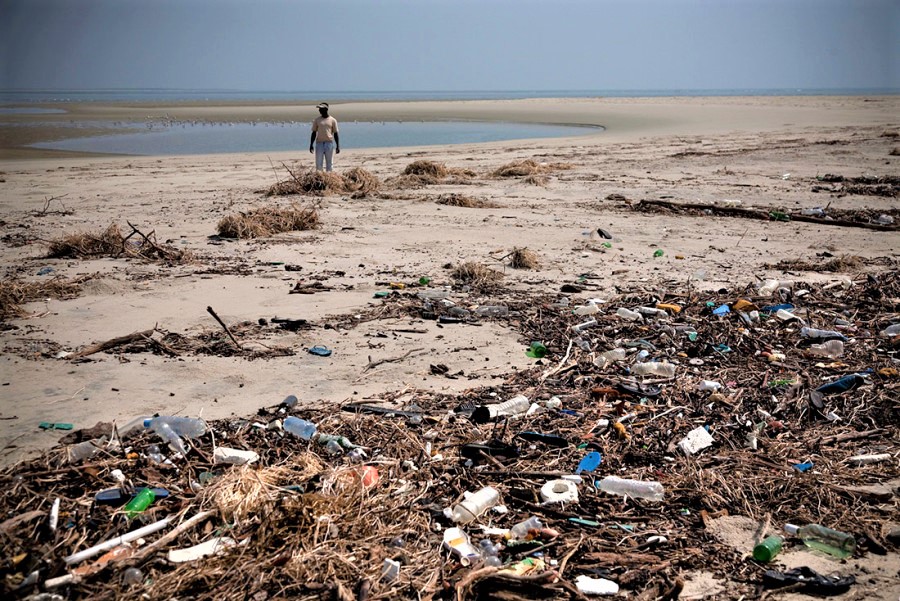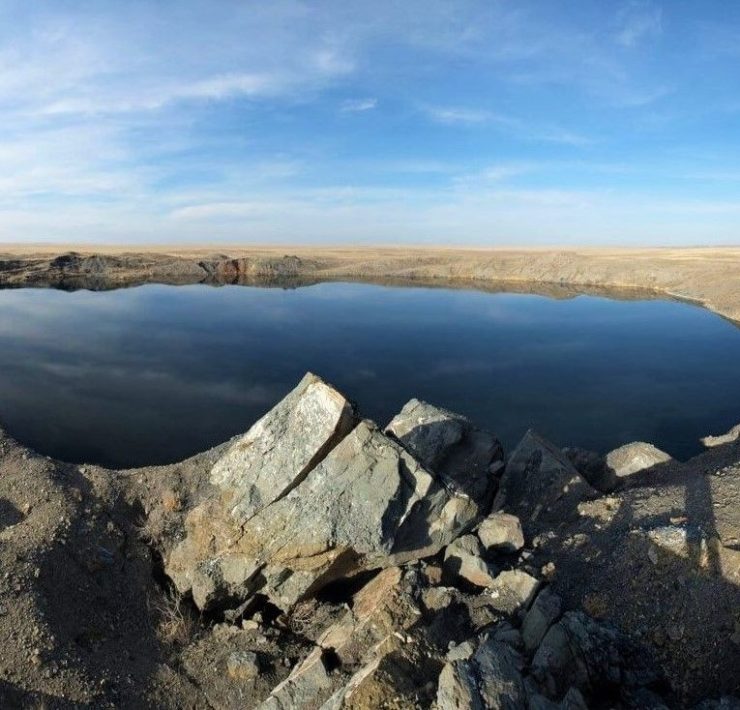The safe disposal of waste, especially electronic waste, remains a challenge for many industrialized countries. Due to the difficulties and cost associated with the proper disposal of waste that contains hazardous components, it is often simply shipped to developing countries as used products.
A lot of effort has been made to curb the dumping of waste in countries without the proper facilities to handle these products, but in many places, the practice continues.
1. Ghana

Ghana is one of the countries in Africa where e-waste from all over the world ends up. The region hit the hardest is Agbogbloshie, which is a former wetland, but is now known as one of the world’s biggest e-waste dumps.
Nicknamed “Sodom and Gomorrah” by the locals, it is a bleak place where waste is burned and valuables stripped from obsolete electronics by scores of workers.
2. Philippines

The port of Manila, in the Philippines, found itself the unwilling dumping place for 50 shipping containers, each about the size of a school bus, full of trash from Canada. The containers were supposed to contain plastic for recycling, but when opened contained garbage, such as dirty diapers along with the plastic.
This is not the first time something like this happened either as Japan also attempted to dump 103 container vans full of garbage in the Philippines but later took it back.
3. Nigeria

About 15 shipping containers filled with discarded electronics are estimated to arrive in Nigeria every day. The containers arrive in the port city of Lagos, where there is a giant electronics market.
Unfortunately, most of the electronics are broken beyond repair and instead end up in dumps where people scavenge for valuable components in dangerous conditions. In past Nigeria also found itself the dumping ground for toxic waste from countries such as Italy.
4. Somalia

Thanks to a Tsunami surge in 2004, hazardous waste containers washed up on the shores of Southern Somalia prompting renewed attention on the issue of illegal dumping in this country.
Hydrogen peroxide toxic waste and radioactive materials were also found in parts of Central and Southern Somalia. According to the UN, some firms took advantage of the lack of functioning government in Somalia to dump waste off its coast for years.
5. China

Although a lot of electronic devices are manufactured in China, many of these devices are shipped back as e-waste to the country despite the bans that are in place.
One of the biggest hubs in the country is the town of Guiyu where the roads are lined with e-waste. It has had a devastating effect on the environment of the area as piles of scrap are dumped in the fields outside town.
6. India

According to reports, a lot of European waste including metals, textiles, and tires end up in India. A lot of illegal e-waste also arrive in this country where whatever cannot be processed by the poorly equipped recycling facilities end up in incinerators or landfills.
India is also the location of the Alang shipyards where about half of all ships that are salvaged around the world are sent for recycling. Ships are beached and then dismantled by hundreds of manual laborers, often in very dangerous conditions.
7. Vietnam

In addition to e-waste generated by its own growing IT industry, Vietnam is also facing problems with the illegal importing of e-waste from other countries. Hundreds of illegal operations have been exposed by agencies such as the Ministry of Public Security’s Department for Combating Environmental Crimes.
These include the illegal importing of 340 tons of electronic spare parts by one local firm as well as thousands of used laptops, computer screens, used electronic chip panels and used chargers brought through the border gate by another company. The country is also home to the “rubbish metropolis” of Minh Khai Village, which receives waste from Vietnam, Europe and Asia.
8. Pakistan

According to the Basel Action Network, more than 500,000 used computers are still sent to Pakistan each year from developed countries. The e-waste is finding its way to Pakistan from countries such as Singapore, the USA and also a few European countries, despite the fact that is in clear violation of international laws.
Only an estimated 15 to 40 percent of the computers are in a usable condition while the rest are recycled by women and children working in extremely hazardous conditions.
9. Bangladesh

Studies by the Environment and Social Development Organization found that more than 83% of child workers are exposed to toxic substances related to e-waste recycling in Bangladesh, while more than 15% of them die each year.
In the past, the country has been a dumping ground for everything from plastic waste and asbestos to defective steel, waste oil lead and used batteries from a variety of countries. In addition to the illegal import of e-waste, the ship breaking industry in Bangladesh is also the second largest in the world and millions of tons of old ships are imported each year.
10. Ivory Coast

Ivory Coast serves as one of the most shocking examples of waste getting dumped illegally in a different country. 500 Metric tons of toxic waste was brought to the country from Europe and then transferred to tanker lorries. The waste was then offloaded, during nighttime, at 14 dump sites scattered around the city of Abidjan.
Since these sites were close to water supplies or fields used for growing the food it caused eight people to die and more than 80,000 to seek medical treatment.
11. Indonesia

Exporting scrap metal to Indonesia is legal as long as certain standards are maintained, but the country still faces problems with illegal waste. This has prompted the country to implement strict measures against the import of contaminated waste. Although labeled as scrap metals, customs officials have found containers where the materials were mixed with sand, plastics, asphalt, and other illegal mixed waste.
1800 tons of suspected contaminated waste was sent back to countries such as the UK in 2012 while in 2011 they sent back 51 waste containers. The capital, Jakarta, is also home to an estimated 500,000 scavengers who make a living searching through e-waste.
12. Kenya

Due to the amount of e-waste shipped to Kenya, the country has implemented an e-waste management project since 2010. Nairobi is home to the first large-scale recycling facility in East Africa where workers can safely deal with the estimated 15,000 tons of electronic waste that are shipped to the country each year.
These consist mostly of mobile phones and computers from countries such as the US. As part of the e-waste recycling initiative in the country, people are also paid to search for electronic products discarded on dump sites and to bring these to collection points.
13. Guinea

In the late 80s, about 15,000 tons of American waste was dumped on the island of Kassa, only four miles from the capital of Guinea on the mainland. The waste came from municipal incinerators in Philadelphia and contained a dangerous mixture of heavy metals as well as toxic dioxins.
The waste was dumped in Guinea by a Norwegian company that was hired to dispose of it and it arrived labeled as raw material for building bricks. The noxious smell and dying vegetation prompted officials to take action and in the end, the waste was returned to the US where it was buried in a landfill.
14. Haiti

Guinea wasn’t the first country to have waste originating from Philadelphia dumped on its doorstep either. 15,000 tons of toxic incinerator ash left the city aboard the vessel, Khian Sea, which headed to the Bahamas.
However, it was turned away and spent 14 months at sea as countries such as Honduras, Bermuda and the Dominican Republic refused to accept its cargo. In the end, 4000 tons of the toxic ash was dumped on a beach near the Haitian city of Gonaives. The ship left quietly in the night before the Haitians realized that the ash wasn’t fertilizer as promised.
15. Mexico

Mexico was another country that served as a dumping ground for hazardous waste products originating in the United States during the 1980s.
The waste ended up in unregulated landfills after crossing the border hidden in other cargo on trucks or trains. Since border officials were more interested in intercepting weapons or illegal drugs a lot of the waste passed by undetected.
16. Zimbabwe

Zimbabwe found itself the recipient of commercial cleaning fluid in the late 80s, but in reality, it was toxic waste. What makes it even worse is that the waste was bought using grants from the U.S Agency for International Development. The waste originated at a Navy base in Norfolk from where it was sent to a warehouse just outside New York.
The toxic waste, which consisted of the residues from painting and degreasing naval equipment was enough to fill 275 barrels. Once these barrels arrived in Zimbabwe it was dumped in a phosphate mine pit. The U.S. exporters who were responsible for the incident were later imprisoned for fraudulent business practices.
17. Guinea-Bissau

According to reports, between 1 million and 3.5 million tons of waste were sent to Guinea Bissau from countries such as Switzerland, the United Kingdom, and the United States. Both pharmaceutical and industrial waste was included in these toxic shipments.
Country officials also signed a five-year contract for the burial of 15 million tons of toxic waste sent over by European pharmaceutical companies and tanneries but repudiated the contract after the public outcry.
18. Lebanon

A Greenpeace report highlighted the case of ships, loaded with toxic waste from Italy that was bound for Romania and Africa. One such ship, the Radhost, sailed to Venezuela in 1987 with 2400 tons of industrial waste as its cargo. The ship was to join another ship, the Lynx, also carrying 2000 tons of industrial waste, in unloading its cargo in Venezuela.
However, the ship was turned away by authorities and ended up delivering its toxic cargo to Lebanon instead. Local media uncovered the story and a campaign was begun to return the toxic waste to Italy.
19. South Africa

An article in New Scientist magazine from 1989 revealed that 120 drums of waste, originating in the United States, was dumped in South Africa. The waste contained sludge that was laced with mercury.
More recently the Basel Action Network also uncovered an illegal attempt by recyclers in the US to illegally export e-waste to South Africa. The e-waste was collected in collaboration with the Western Pennsylvania Humane Society under the pretense that it would be recycled in the US, but then loaded onto a ship and sent to Durban.
20. Sweden

Sweden is one of the few countries that actually welcomes the trash it receives from other countries. This is because less than 1% of the garbage originating in Sweden actually in up in the dump.
The rest is recycled or burned at special plants to generate heat for homes. The process is so efficient that Sweden ran out of the trash and started importing garbage from Norway, Ireland, Italy, and the U.K.
Kailey is a travel writer currently based in New York, but mostly on the move. She loves sharing interesting stories from her experiences with the local culture, food and adventure activities through her writing. When she is not eating french fries and sipping wine, you can find her traveling to different areas, capturing new stories, teaching yoga, or working on her helicopter license.







This entire post absolutely ROCKS! Thank you for all the hard work you put into it. It really shows.